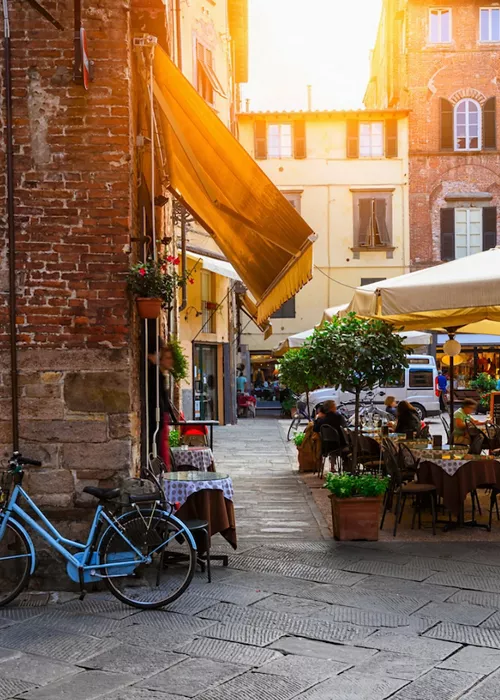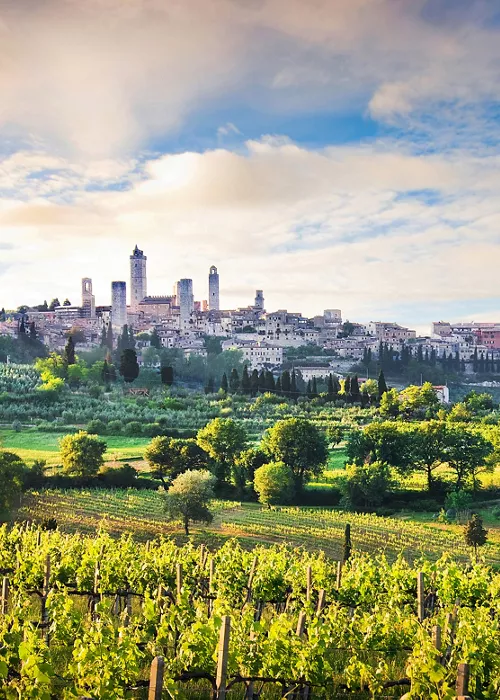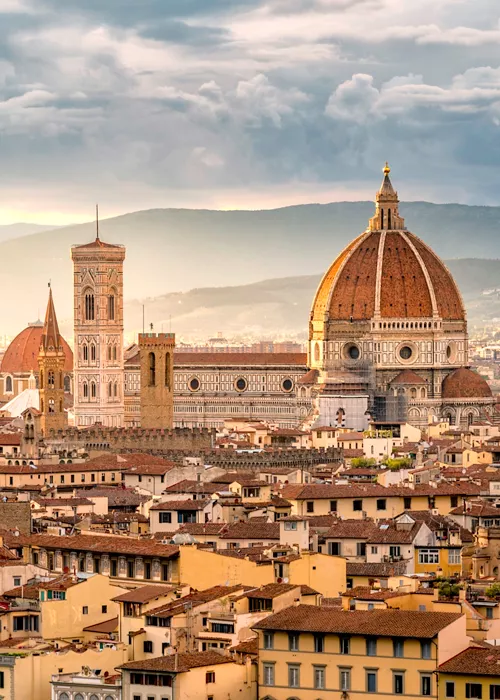Lucca, a Tuscan jewel surrounded by imposing walls
4 minutes
Lucca, one of Tuscany’s main towns, is one of the most fascinating and best-preserved medieval cities in Italy: with great honour for its historical and cultural memory, which it carefully preserves, it captivates visitors with its picturesque alleys, squares and characteristic churches.
Symbolic of the city, the imposing 16th-century walls are one of the few examples of city walls that have remained completely intact in Italy. Fascinating to admire, they constitute an ideal excuse for a tour of the countryside while offering a vantage point to see the urban structure of the city, commissioned by the Romans, which is unique in its beauty and harmony to this day.
Lucca's wealth of history and monuments, its hospitable and cheerful climate, and its proximity to unspoilt nature make it the perfect destination to discover a touch of genuine Tuscany.
History and particularities of Lucca

Many events have made Lucca's history special ever since its foundation: some experts believe it was born as a Ligurian settlement, others believe it had Etruscan origins and later itself as a Roman city, as demonstrated by many artefacts still visible today in the streets of the historic centre.
Occupied by the Goths then the Byzantines and the Franks, it became one of the most important capitals of the Lombard kingdom, and Charlemagne endowed it with more lustre by making it the home of Aldalberto I, Marquis of Tuscany.
The Middle Ages ensured further growth for Lucca, which became a pilgrimage destination on the Via Francigena thanks to the presence of the Holy Face in the church of San Martino. Despite the constant fighting between Guelphs and Ghibellines, in the 14th century Lucca was undoubtedly one of the most important cities of the Italian Middle Ages. A period of great decadence followed under the subsequent rule of the Visconti family and the dictatorship of Giovanni Dell'Agnello, Doge of the Republic of Pisa.
Having obtained its freedom again in 1370 thanks to the intervention of Emperor Charles IV, Lucca chose a republican government and returned to fame in Europe. After the brief period of the Signoria of Paolo Guinigi, Lucca remained an independent republic until 1799, when it fell under Austrian rule. It became a principality and then a duchy of Maria Luisa of Bourbon, and finally entered the Grand Duchy of Tuscany. In 1860 Lucca became part of the Kingdom of Italy.
What to see in Lucca: 3 must-see places

With its wealth of history and architecture, you will certainly find yourself in front of a dilemma: what to see in Lucca to get into the spirit of the city? Here are 3 sights to start with.
- Lucca and its towers: visit Guinigi Tower, built by a powerful family of merchants from Lucca in the 15th century. Standing 45 metres high, at the top there is a roof garden where spectacular holm oaks grow.
- The symbol of Lucca: it is imperative to dedicate some time to the imposing Walls of Lucca. A full 12 metres high and 4 kilometres long, they feature a beautiful tree-lined avenue for exercising, walking, events or enjoying the view over the city
- Lucca's Baroque garden: the last unmissable destination is Palazzo Pfanner, a 17th century palace with an Italian Baroque garden to admire. The setting for many important films, it became the property of the Pfanner family, brewers who built the first brewery in the Duchy of Lucca in 1846.
What to do in Lucca: 3 ideas

With its central streets dotted with boutiques, elegant shops and patisseries, the city leaves no room for boredom. But what can you do in Lucca with the whole family? Perfect for entertaining both young and old, Lucca Comics is a must-see event: it is an international fair dedicated to comics, games, animation, video games and the world of fantasy and science fiction. It takes place every year between late October and early November and attracts tourists from all over the world.
Music lovers, on the other hand, cannot miss the Lucca Summer Festival, a packed programme of concerts, while sports enthusiasts will be delighted to cycle along the Via Francigena from Lucca to Siena along a breathtaking scenic route.
What to eat in Lucca: 3 specialities

Lucca’s gastronomical traditions are truly irresistible! It is a genuine, simple cuisine that owes much to its humble agricultural origins and is based on seasonally available crops.
What to eat in Lucca? You can’t miss these three specialities:
- Start with garmugia, a spring soup made with artichokes, peas, asparagus and bacon served with toasted bread.
- Considered a gourmet speciality, tordelli lucchesi are fresh pasta tortelli stuffed with pork and beef, broth-soaked bread, Parmesan cheese, eggs and herbs, then dressed with meat sauce and a sprinkling of cheese.
- Finally, the buccellato di Lucca is a sure winner for those with a sweet tooth with its doughnut shape and aniseed aroma. Here it is eaten by dipping it in wine.
Unique places in Lucca

Of all the usual places in Lucca, the Ponte del Diavolo (Devil's Bridge) will win you over at first sight with its spectacular shape. Stop a born-and-bred Lucca local and ask them about the legend of this enchanting place.
Another place off the tourist track worth visiting is the Volto Santo of Lucca, the Holy Face of Lucca: the large wooden crucifix inside the cathedral of San Martino, depicting the countenance of Jesus, is striking. His eyes, expressive and large, seem to follow the gaze of the beholder.
Finally, a last piece of advice: take some time to look at the Pietra del Diavolo (Devil's Stone) of Lucca, found on the first window of Palazzo Bernardini. One of the stone window jambs is unnaturally curved, so that it looks fake. Legend has it that the devil convinced the Bernardini lords to build an imperial palace where there was a miraculous image of the Madonna, which was destroyed to make way for the building. Right there, the stone curved outwards and remained so forever, despite the many attempts to straighten it.























